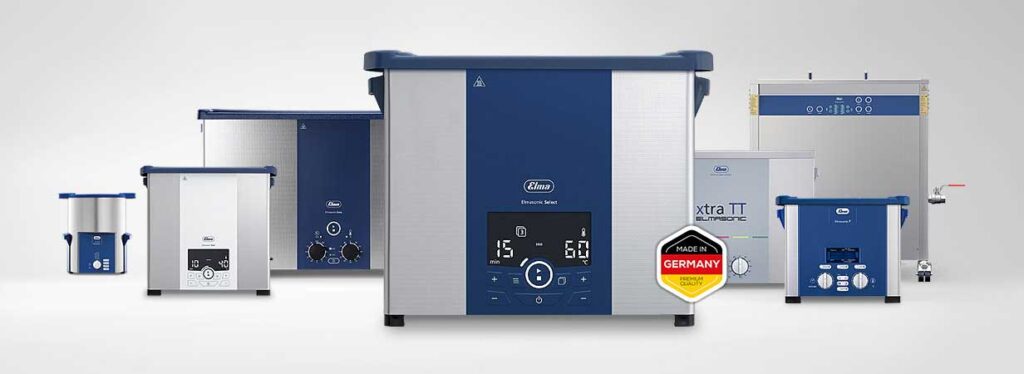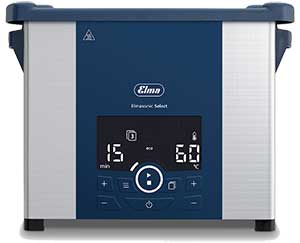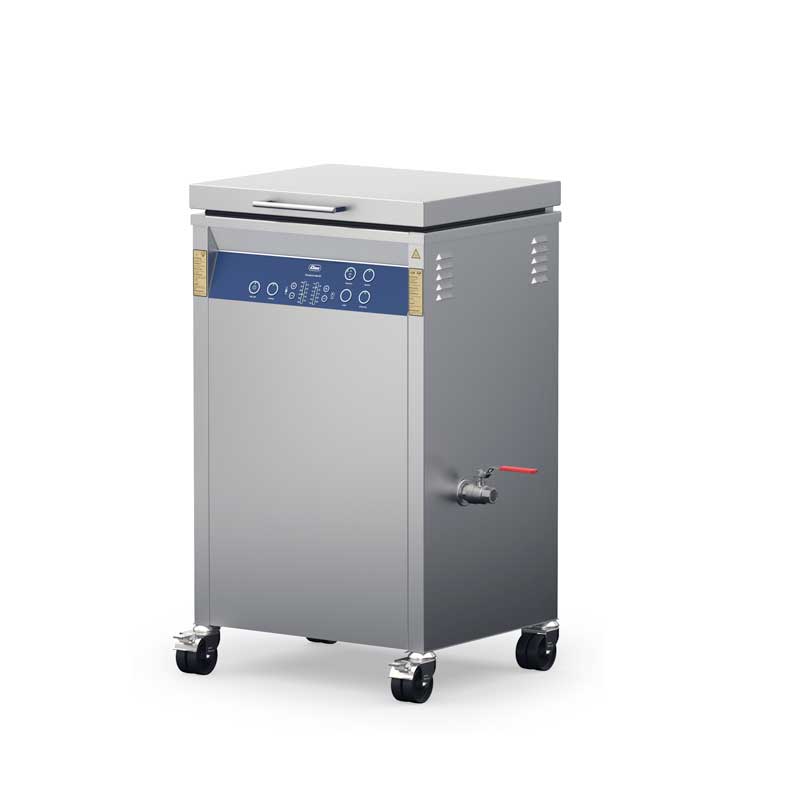
Specifying an Ultrasonic Cleaner
Specifying an ultrasonic cleaner for a specific application requires careful consideration of several key factors to ensure effective and efficient cleaning. The process involves more than just selecting a machine; it necessitates a comprehensive understanding of the technology, the cleaning task at hand, and the proper operational procedures.
Before proceeding further, first determine how you plan to use your equipment:
- Will your equipment be used to clean parts?
- Will your equipment be used to process samples in the lab (serve as a lab sonicator)?
This post focuses on the first application. While many of the points covered apply to both applications, if you are seeking advice on the second, additional useful information is found in our laboratory sonicator guide.
At the end we provide a series of Application Notes describing how companies put their ultrasonic cleaning equipment to work.
First Steps in Specifying an Ultrasonic Cleaner
Ultrasonic cleaners are offered in sizes ranging from benchtop units with tank capacities of less than a gallon to floor mounted units holding 200 gallons or more of ultrasonic cleaning solution chemicals.
Having the answer to these points will help you make the correct decisions.
- What size parts are being cleaned?
- How many parts will be cleaned per cycle without crowding?
- Will your equipment be used occasionally – one or two cycles per day, or continuously – such as on a shift basis? If the latter, you’ll need units with heavy-duty welded stainless-steel tanks rather than pressed stainless steel.
- Will you be using aqueous-based biodegradable cleaning solutions or require volatile solvents to achieve required results? If the latter, you must comply with strict operating and equipment requirements.
This guide will walk you through the essential points to consider when specifying an ultrasonic cleaner, from equipment size and ultrasonic frequencies to operating features, procedures, and the crucial role of cleaning solutions.
1. Correct Equipment Size
Selecting the right size for an ultrasonic cleaner is paramount. A tank that’s too small won’t be able to accommodate the parts you need to clean, while one that’s too large can be inefficient and wasteful.
Tank Dimensions
First, measure the largest part or assembly you intend to clean. The internal tank dimensions (width, depth and height) must be large enough to submerge the part completely without it touching the bottom or sides of the tank.
For that reason, most ultrasonic cleaning is accomplished in baskets. Otherwise, parts contacting the walls or bottom of the cleaning tank will vibrate, eventually causing damage to the tank. Baskets also keep parts at the optimum position in the tank to help ensure thorough cleaning, and facilitate loading and removing parts from the cleaning bath.

As an example, the 2.4-gallon Elmasonic Select 80 has tank dimensions 19.9 x 5.4 x 5.9 inches (WDH) while the recommended basket size is 17.9 x 4.1 x 3.7 inches. The Elmasonic Select series is offered in 11 tank sizes from 0.75 to 24 gallons.
If your requirements call for benchtop heavy-duty cleaning on a shift basis, a recommended alternate is the industrial Elmasonic Xtra series featuring welded stainless-steel tanks designed to operate on production cleaning cycles up to 8 hours.
For cleaning larger parts on industrial scale, the Elmasonic xtra ST series is offered in 7 tank sizes from 8 to 67 gallons. These units are designed for a continuous 8-hour a day operation.
Further information on large part and large scale cleaning is offered in Choosing the Right Industrial Ultrasonic Cleaner.
Cleaning Basket Accessories
Several accessories are available to assist you in positioning parts in an ultrasonic cleaner – including options on customizing your basket configuration. We invite you to click here to download our list of baskets, pins and other accessories that can help boost your efficiency and throughput.
Note: The exception to baskets occurs when cleaning large parts such as engine blocks or transmissions. In such cases these can be suspended in the solution by overhead cranes or rest on special supports welded to the tank bottom of specially designed industrial ultrasonic cleaners.
Tank Volume
The tank’s volume capacity is also important. The total volume of the items to be cleaned should not exceed approximately 70% of the tank’s liquid volume. This prevents the parts from displacing too much of the cleaning solution, which reduces the effectiveness of the ultrasonic action.
Most ultrasonic cleaners are equipped with a fill line or other designation of proper solution volume.
2. Ultrasonic Frequencies
Ultrasonic cleaners operate by generating high-frequency sound waves that create microscopic bubbles in the cleaning solution, a process known as cavitation. The frequency of these sound waves, measured in kilohertz (kHz), directly influences the size and intensity of these bubbles, which in turn determines the cleaning action.
Most ultrasonic cleaners operate between 35 and 45 kHz. This frequency range is well suited to the vast majority of cleaning tasks.
A lower frequency such as 25 kHz produces larger cavitation bubbles ideal for coarse cleaning such as removal of lapping abrasives or polishing paste.
Frequencies such as 37 and 80 kHz are commonly used for routine cleaning, for lab applications and cleaning fine-featured complex surfaces.
Examples of benchtop cleaners operating at the popular 37 kHz frequency include the Elmasonic E Plus and Elmasonic Select series.
Multiple Frequencies
Some advanced ultrasonic cleaners offer multiple frequencies or the ability to switch between them. This feature provides versatility, allowing a single machine to handle a wide range of cleaning applications. For example, a lower frequency can be used for an initial aggressive clean, followed by a higher frequency for a final, detailed clean.

Multiple frequency operation such as found in the 37/80 kHz Elmasonic P Series is also useful when the units are employed to clean delicate laboratory glassware and instruments, and as sonicator baths and similar sample prep activities in the lab.
For industrial applications the floor-mounted Elma X-tra ST units can be set to 25 kHz for basic cleaning and to 45 kHz for fine cleaning.
Our post ultrasonic frequency and power goes into more detail on this subject.
3. Operating Features
Modern ultrasonic cleaners come with a variety of operating features that enhance their performance and user-friendliness.
Heater
A heater is a crucial feature. Most cleaning solutions are more effective when heated. Increasing the temperature of the solution reduces its viscosity and surface tension, allowing the ultrasonic waves to propagate more efficiently and the cavitation bubbles to form more readily. The optimal temperature range for most applications is 50°C to 70°C (122°F to 158°F).
Suppliers of ultrasonic cleaning chemicals (discussed below) provide recommended bath temperatures.
Degas Function
The presence of dissolved gases in the cleaning solution can significantly inhibit cavitation. A degas function works by rapidly pulsing the ultrasonic energy to drive these gases out of the solution, improving the cleaning efficiency from the start. This is particularly useful when using a fresh batch of cleaning solution.
Sweep and Pulse Modes
Sweep mode modulates the ultrasonic frequency slightly around a central point, creating a more uniform distribution of cleaning energy and eliminating “standing waves” that can result in uneven cleaning. Pulse mode delivers short, powerful bursts of ultrasonic energy, which can be useful for removing particularly stubborn contaminants.
Eco and Dynamic Modes
Eco mode provides a quiet, gentle cleaning operation ideal for delicate products. Dynamic mode combines Sweep and Pulse for uniform cleaning that can involve stubborn, tenacious contaminants.
Timers and Microprocessor Controls
A built-in timer allows for precise control over the cleaning cycle, ensuring consistency. Microprocessor controls offer greater precision and ease of use.
The Elmasonic Select series is an example of benchtop ultrasonic cleaners offering all these features.
You might also find useful information in the answers to Ultrasonic Cleaning FAQs.
4. Operating Procedures
Following correct operating procedures is vital for maximizing the effectiveness of the ultrasonic cleaner and ensuring safety.
Filling the Tank
Always fill the tank with the cleaning solution before turning on the ultrasonic function. We suggest adding water to fill the tank half way, add the correct amount of cleaning solution chemical for a full tank, then continue adding water to the tank’s fill line. Operating the cleaner with insufficient solution or with no solution can cause irreversible damage to the transducers.
Mixing and Degassing the Solution
After filling the tank, it is essential to mix and degas the new solution. Run the cleaner for 5-10 minutes with the degas function on (if available) or by simply running it without any parts in the basket. This process removes trapped air and ensures the solution is ready for optimal cleaning.
Loading the Basket
Place the parts to be cleaned in the cleaning basket in such a way that they are not in contact with each other. As noted earlier, the basket makes it easy to inspect and retrieve the clean parts. Cautionary Note: Never reach into an operating ultrasonic bath.
Cleaning Cycle
Set the appropriate temperature and timer. The duration of the cleaning cycle will vary depending on the level of contamination and the type of parts. Start with a shorter cycle (e.g., 5-10 minutes) and inspect the parts. If necessary, repeat the cycle. With practice, you’ll get your procedure down pat.
5. Cleaning Solution Chemicals
The cleaning solution is a critical component of the ultrasonic cleaning process. The wrong solution can damage the parts or the cleaner, while the right one can dramatically improve results.
Types of Solutions
Cleaning solutions are typically biodegradable aqueous (water-based) and formulated with specific chemistries to target different types of contaminants.
- Mild Detergents: For general-purpose cleaning of light dirt, dust, and grime.
- Alkaline Solutions: Excellent for removing oils, grease, waxes, and carbon deposits. These are highly effective for industrial parts.
- Acidic Solutions: Used for descaling, rust removal, and cleaning mineral deposits. Use with caution, as they can be corrosive.
- Specialty Solutions: Formulated for specific materials (e.g., plastic, glass, aluminum) or contaminants (e.g., blood, flux, polishing compounds).
For more details on critical topic, see How to Select the Best Ultrasonic Cleaning Solutions.
- Volatile Solvent-Based Solutions: Low flash-point solvents such as acetone, IPA and toluene call for strict precautions as to equipment and operating environment. Equipment and practices suggestions are found in Selecting an Explosion Proof Ultrasonic Cleaner.
Safety and Handling
Always consult the Safety Data Sheet (SDS) for any cleaning solution. Wear appropriate Personal Protective Equipment (PPE), such as gloves and eye protection, when handling chemicals. Ensure the cleaning area is well-ventilated, and follow all disposal guidelines for used solutions.
Ultrasonic Cleaning Applications
Check these posts to see how companies have employed the energy of ultrasonic cavitation to solve their cleaning and processing challenges.
- How ultrasonic cleaning meets Volkswagen’s fuel injector cleaning specs
- Cleaning trucking industry DPF and EGR filters
- Removing contaminants from finely machined parts in the metalworking industry
- Removing soldering flux, residues and dirt from new and reconditioned PCBs
- Jet engine maintenance and operation procedures
- Removing 3-D printing mold support
- Case study on safely using flammable solvents to clean stainless steel filters
- Solvent cleaning adhesive gun and spray paint nozzles
- Sample processing and instrument cleaning in the lab
Summing Up Ultrasonic Cleaning
Specifying an ultrasonic cleaner is a multi-step process that requires a detailed assessment of your cleaning needs. By carefully considering the correct equipment size, the optimal ultrasonic frequency, the benefits of various operating features, the importance of proper operating procedures, and the role of the right cleaning solution, you can select and utilize a system that provides consistent, high-quality cleaning results for your specific application.
Contact Tovatech’s Cleaning Experts for Advice
We’ll provide expert and unbiased recommendations on selecting ultrasonic cleaning solutions, equipment and operating procedures.
